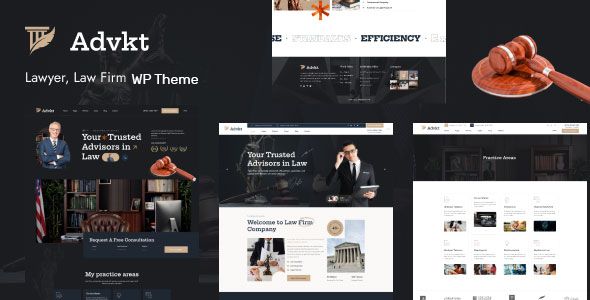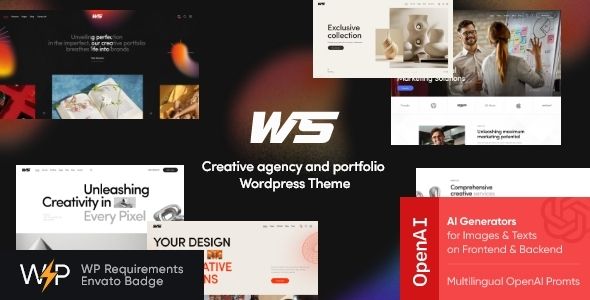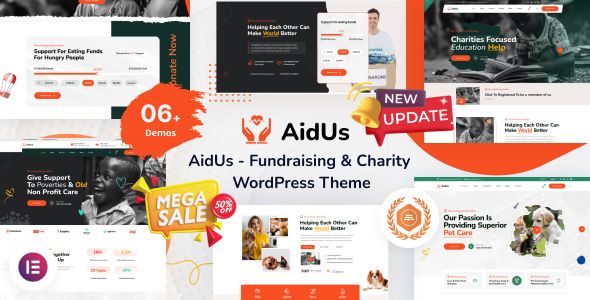Agenca – Web Design Agency WordPress Theme

- Description
- Reviews
- FAQ

You’re getting Agenca – Web Design Agency WordPress Theme in a version that gives you real freedom: install it on unlimited websites, keep every premium layout and feature intact, and stay aligned with the official release track for updates. There are no per-domain activations, no keys to babysit, and no awkward prompts appearing when you hand off a site to a client. In day-to-day work this means you can prototype on localhost in the morning, stage on a subdomain in the afternoon, and ship a polished agency site the same evening—then reuse the exact same package for the next client without friction. The result is less time fiddling with licensing and more time composing pages that convert.
Why this theme is built for real agencies (not just pretty screenshots)
Most “agency” themes look good in demos and then bog down when you try to mirror actual services, case studies, pricing, recruitment, and support requests. Agenca – Web Design Agency WordPress Theme starts with the workflows a studio runs every week:
-
A homepage that sells a positioning statement, not just a carousel.
-
Service clusters that map to what you actually deliver: web design, UX sprints, branding, landing pages, eCommerce, SEO, copywriting, and retainers.
-
Case study scaffolds that capture problem → approach → outcome with clean metrics, galleries, and a single bold takeaway.
-
Pricing and “engagement model” sections that make it safe to talk about money without boxing you into a single number.
-
Intake forms you can keep short in context and deep on a dedicated brief page.
-
Careers pages that don’t read like an HR portal but still say what it’s like to work with you.
-
A blog/resources area that behaves like an editorial site—reference guides, teardown posts, and launch notes—rather than an afterthought.
Because your package can be installed on unlimited domains with the full feature set, you can standardize on a single, proven base for a network of microsites, sister brands, or a fleet of client projects.
The design language: confident, modern, and calm under pressure
Agenca’s design system aims for that hard-to-fake mix of authority and friendliness. Expect:
-
Measured whitespace that gives headlines and proof points room to breathe.
-
Typographic tokens that keep headlines sharp and body copy readable on mobile; swap font families globally without breaking rhythm.
-
Color tokens for brand tones and semantic states (success, neutral, warning) so notices and forms feel native.
-
Hero patterns that work with photos, abstract shapes, or subtle video—and degrade gracefully for smaller screens.
-
Motion defaults that are present but never dramatic: quick fades, light parallax at sane thresholds, and purposeful hover cues.
It’s modern without leaning on novelty for attention, which helps when your audience is a mix of operators, marketers, and founders.
What’s inside (and why each piece matters)
-
The complete Agenca – Web Design Agency WordPress Theme with all premium demos and section blocks.
-
A deep library of ready-to-drop sections: feature grids, process timelines, comparison strips, pricing tables with monthly/annual toggles, testimonial carousels, FAQ accordions, logo walls, and sticky CTAs.
-
Case study layouts: hero + summary metrics, image sequences, split text/image bands, pull quotes, and a clear “work with us” CTA.
-
Blog and resource templates that handle long-form posts, guide indexes, and category collections without turning your site into a generic tech blog.
-
Header/footer presets—minimal, centered, split nav with right-aligned CTA, and a reduced-chrome landing variant.
-
A one-click demo importer that stands up a sensible structure in minutes.
-
Update packages that stay in step with official releases, so you aren’t stuck on a stale snapshot.
The idea is simple: you grab the building blocks you need, assemble a narrative in a couple of focused passes, and ship.
Page building without lock-in
Whether you favor Gutenberg for longevity or rely on Elementor for speed, Agenca gets out of your way:
-
Block patterns cover the core: heroes, features, proof sweeps, process timelines, pricing, FAQs, and resource cards.
-
Elementor sections mirror those patterns so your team can move fast on tight deadlines.
-
Global styles keep color, type, and spacing consistent; make a change once and watch it cascade.
-
Use a child theme for any PHP or template overrides; the parent stays update-friendly.
Because you can reuse the same package across unlimited sites, you can also keep a private library of your best-performing sections and drop them into new builds in minutes.
A site architecture that mirrors real sales journeys
Agenca – Web Design Agency WordPress Theme supports an IA that matches how buyers explore:
-
Positioning homepage → short, outcome-driven claims with quick proof and an obvious next step.
-
Services hub → tiles for Design, Development, eCommerce, CRO, SEO, Brand, and “Ongoing Care,” each leading to focused service pages.
-
Industries hub → SaaS, DTC, B2B services, hospitality, education—same structure, different language and examples.
-
Case library → filterable by industry and capability; each case has a clean metrics snapshot.
-
Resources → buying guides, teardown posts, checklists, and templates that lead back to services and booking.
-
Contact & intake → a snippet form embedded across the site; a detailed brief page for serious buyers.
This scaffolding avoids two common sins: vague “capabilities” pages and case study walls that look great but convert poorly. Everything is built to nudge a measured next step.
Conversion, but tastefully
Agencies often under-optimize because they fear “salesy.” Agenca keeps the tone professional while stacking tiny advantages:
-
CTA rhythm: the primary action (“Book a call” or “Get a proposal”) recurs at natural breaks.
-
Short forms inline; deep forms where they belong.
-
Trust strips: client logos, review snippets, awards—restrained and in grayscale if you want.
-
Pricing with notes: either a range (“Typical projects $8k–$25k”) or engagement models with bullets; pair with micro-FAQs that defuse objections.
-
Social proof near friction: a metric, a short quote, or a “result at a glance” box adjacent to your primary CTA.
-
Exit guardrails: polite prompts (“Would you like the checklist we use for kickoffs?”) rather than a full-screen blockade.
It feels like a well-run studio, not a funnel. And because your package is reusable, you can A/B test copy variants across multiple client sites and fold the winners into your master kit.
Performance and Core Web Vitals: designed to pass without heroics
A site for builders should itself be well built. Agenca’s asset loading and component dimensions are crafted to protect LCP, CLS, and INP:
-
Responsive images with sane width caps for hero media.
-
Lazy-loading beyond the first screen; skeleton placeholders optional.
-
Predictable component boxes so text, buttons, and media don’t jump.
-
Modular CSS/JS so you can defer or delay non-critical assets.
-
Friendly defaults with caching and a CDN—no weird blockers or inline script surprises.
On mid-range phones over 4G, pages still feel instant. That matters when prospects visit from a hallway between meetings.
SEO scaffolding that respects readers
You don’t need trickery; you need clarity:
-
Clean H1/H2/H3 hierarchies and readable slugs.
-
Breadcrumbs for orientation on long case libraries.
-
Schema-ready blocks for organization and FAQ.
-
Category and tag archives that actually look curated.
-
Honest alt text, descriptive captions, and internal links from services → cases → resources.
Search engines understand it; readers appreciate it.
Accessibility and mobile ergonomics
The theme ships with visible focus states, keyboard-operable menus and accordions, labeled form inputs, and high-contrast options for notices. Tap targets are generous; sticky bars appear where useful, not everywhere. Good accessibility helps late-night readers and screen-reader users—and passes client audits.
Installation (predictable, quick, repeatable)
-
Upload & activate the theme via Appearance → Themes → Add New → Upload.
-
Install suggested plugins (forms, optional companion, your preferred builder).
-
Import a demo closest to your positioning (boutique studio, performance-driven agency, product design, or generalist).
-
Set Home & Blog, assign menus, and tune global colors and typography.
-
Replace demo content systematically—hero copy, service bullets, case metrics, team bios, imagery.
-
Wire forms to your CRM or inbox; test deliverability and spam rules.
-
Enable caching & image optimization; test on a real phone over cellular.
-
Review accessibility (focus order, ARIA labels, alt text) before go-live.
Because there’s no per-domain activation ritual, the process is the same for one site or ten.
Updating without surprises
Your package tracks the official release line, so updates are calm:
-
Back up files and database.
-
Update on staging; verify header/footer behavior, menus, forms, case templates, and performance.
-
Keep any PHP/template overrides in a child theme; style changes live in global tokens and blocks.
-
Re-measure Core Web Vitals after a major builder update.
-
Push to production during a short maintenance window.
Write the checklist once, then use it on every build.
Content ideas you can publish this month (that actually convert)
-
Framework one-pagers: “Our 3-week UX sprint,” “Landing page playbook,” “Performance hardening checklist.”
-
Short teardowns: “We reduced bounce by 19% on a product page—what mattered.”
-
Industry pages that speak the language: SaaS (activation, churn), DTC (AOV, LTV), B2B (pipeline, CAC payback).
-
Pricing explainers: outline models, what changes bands, and what happens after handoff.
-
Case snapshots: one graph, one quote, one result; link to the full case.
-
Recruiting notes: the tools you use, your stance on pair design or code reviews, expectations in the first 30 days.
All of these sit neatly in Agenca’s patterns, which means you can publish without inventing a new layout every time.
Team and careers pages that feel human
People want to know who they’ll work with. Agenca includes:
-
Team grid with consistent portrait styling, roles, short bios, and “asks me about” tags.
-
Culture strip—a quiet band that says how you work (weekly critique, async standups, flexible hours).
-
Open roles with clear responsibilities, tools, and hiring steps.
-
Application form that doesn’t bury candidates in fields; portfolio links where relevant.
The tone is professional and warm, which attracts better applicants and reassures clients.
Real deployment patterns for agencies
-
Master baseline → many clients: keep a master site with saved blocks and global tokens; clone, swap palette and type, change hero and services, and ship.
-
Sister brands: maintain the parent, give each brand a child theme and its own tokens; share sections and core pages.
-
Campaign landers: use the reduced-chrome header and CTA-first flow for ads or event registrations; convert to recap mode post-event.
-
Private proposal hubs: password-protected pages with curated case sets and engagement notes for a single prospect.
Because you can reuse the package indefinitely, you can invest in a high-quality baseline and amortize it across dozens of launches.
Common pitfalls Agenca helps you avoid
-
Over-decorated pages that obscure the message—defaults are crisp and restraint is baked in.
-
Inconsistent spacing and card styles after edits—global tokens and patterns enforce rhythm.
-
Slow heroes and jumpy layouts—predictable media boxes and lazy-loading protect Web Vitals.
-
Vague services—copy blocks nudge you toward outcome-first language and specific deliverables.
-
License friction during handoff—your package doesn’t interrupt editors with activation prompts.
A realistic launch checklist (pin this)
-
Replace all demo copy and images; no placeholders in production.
-
Validate forms (required fields, thank-you routes, CRM handoff, deliverability).
-
Confirm mobile nav behavior, focus order, and sticky CTA visibility.
-
Audit titles, meta descriptions, and internal links across services, cases, and resources.
-
Compress hero images; verify lazy-load and LCP.
-
Test 404 and search UX; make empty states helpful.
-
Instrument analytics and conversions (CTA clicks, form submits, resource downloads).
-
Add Privacy and Terms pages; link them in the footer.
-
Do a real-device 4G pass on Home → Service → Case → Contact.
-
Create a short “How we start projects” page to set expectations for discovery, timelines, and communication.
Run the checklist once, reuse forever.
FAQ
Q1: What exactly do I receive with this build of Agenca – Web Design Agency WordPress Theme?
The full theme with all premium demos and sections, importer tools, global style controls, and updates that track the official release. You can install it on unlimited domains—local, staging, production, and client sites.
Q2: Will I hit activation popups or per-domain checks?
No. The package is ready to use after install. You can import demos, edit templates, and hand off to clients without license prompts interrupting basic tasks.
Q3: Do I need a specific page builder?
No. Agenca ships with polished patterns for native WordPress blocks and also includes section templates for popular builders. Choose the workflow your team maintains best.
Q4: Can I be transparent about pricing?
Yes. Use range cards or engagement model blocks with micro-FAQs. Many agencies see fewer low-fit inquiries when they publish realistic ranges.
Q5: How does Agenca handle big image sets for case studies?
Galleries and lightboxes are optimized for responsive sizes; export images at sane widths, and the theme handles the rest. Layout shift is controlled by predictable media boxes.
Q6: Will this slow down if we use video heroes?
Keep video light, mute on load, and provide an image fallback for mobile. Agenca’s loading strategy and lazy-loading help maintain performance.
Q7: Is it suitable for multilingual sites and right-to-left languages?
Yes. It’s translation-ready and includes RTL styling so right-to-left scripts render correctly.
Q8: What’s the safest update workflow?
Back up, update on staging, verify headers/footers, menus, forms, case templates, and Web Vitals, then push to production. Keep any PHP overrides in a child theme.
Q9: Can I embed scheduling tools or proposal software?
Yes. Use a dedicated “Book a Call” page or inline CTAs that open modals. Keep embeds lean and load them after interaction when possible.
Q10: Does the theme play nicely with SEO plugins and schema?
Yes. Headings are logical; breadcrumbs are supported; FAQ and organization schema can be added without template surgery.
Q11: Can I host gated resources?
Absolutely. Style a short form beside a resource card, then deliver the asset on a thank-you page or via email. Keep the gate polite.
Q12: Will the look fall apart if a client edits pages themselves?
Global styles and consistent section patterns protect the aesthetic. Provide a short content guide, and non-designers can edit safely.
Q13: Do you support a portfolio grid with mixed aspect ratios?
Yes—masonry and grid options exist. For the cleanest rhythm, standardize ratios within each case set.
Q14: How do I keep accessibility strong after customization?
Maintain contrast, keep labels visible, respect focus order, and test keyboard navigation. Agenca’s defaults start you on solid ground.
Q15: Can I run webinars or events?
Use the event landing layout (speakers, schedule, registration). Post-event, flip the page to recap mode with highlights and replay.
Q16: Does the theme help with proposals and RFPs?
Create password-protected pages tailored to a single client—curated case sets, scope notes, and next steps—using the same blocks.
Q17: What about a one-page site?
Use the landing header, stack hero → proof → services → process → pricing/CTA → FAQ. Expand to full IA when you’re ready.
Q18: Is there a child theme?
You can (and should) use one for PHP/template overrides. Keep layout and visual changes in global tokens and blocks for smooth updates.
Q19: How do I prevent layout shifts when variant images load in case galleries?
Reserve image space with consistent aspect ratios; Agenca’s galleries respect those boxes and minimize CLS.
Q20: Is Agenca – Web Design Agency WordPress Theme suitable for enterprise buyers?
Yes. Build long-form service pages with SLAs, compliance notes, and stakeholder quotes. The design language stays professional and understated.
Final thoughts
A strong agency site does three things: states a clear promise, proves it quickly, and offers an obvious next step. Agenca – Web Design Agency WordPress Theme is engineered around those moves. You get a modern design system, a library of sections that punch above their weight, case study scaffolds that make outcomes legible, and performance that holds up in the real world. Most importantly, your package gives you limitless site usage, every premium feature intact, and updates that follow the official release—so you can build once, refine your playbook, and repeat it across clients and campaigns without licensing hurdles or layout gymnastics.
Q: Do I need a license key?
A: No. All products are Pre-Activated. You can use 100% of the Premium features immediately.
Q: Can I use the One-Click Demo Import?
A: Yes, absolutely! We ensure the demo import feature works perfectly.
Q: Can I use the products on multiple websites?
A: Absolutely. The GPL license allows use on unlimited domains.
Q: Are the files safe?
A: Yes. All files are scanned by McAfee and VirusTotal before uploading.
Share Now!

















